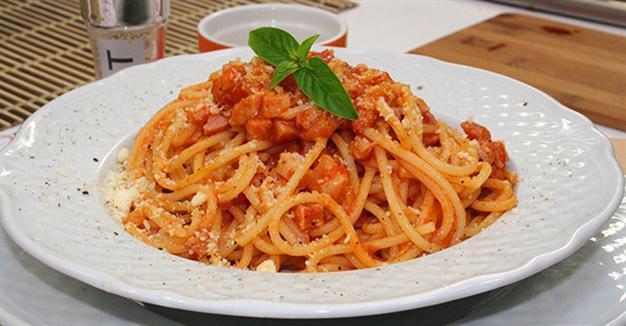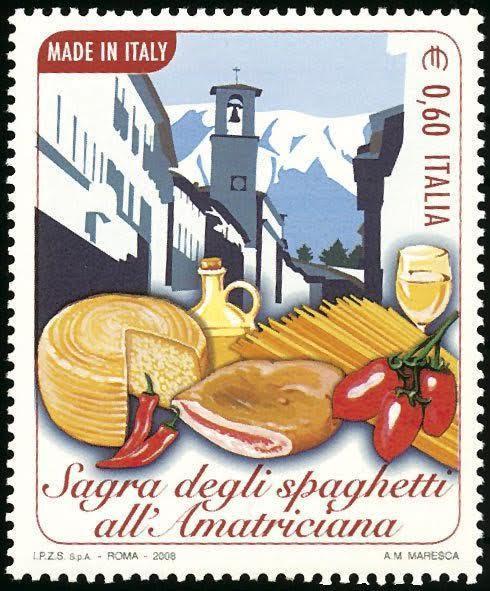The power of pasta
Aylin Öney Tan - aylinoneytan@yahoo.com
 The 50th anniversary meant a lot. The day was going to be special. As always, it was going to be a big celebration with wine flowing, music playing and crowds cheering, all to praise bowls and bowls of pasta. But what a pasta! The past weekend was going to be the 50th Edizione di Sagra degli Spaghetti all’Amatriciana in the picturesque and postcard pretty Amatrice, Italy. Salsa all’Amatriciana is one of the iconic pasta sauces of Italy and named after the town. The town square that was getting ready for the big day is just a pile of rubble now. As the mayor of Amatrice simply put it: “Non c’è più!” There is no more! Neither the square nor the pasta festival; most of the town itself is not there anymore.
The 50th anniversary meant a lot. The day was going to be special. As always, it was going to be a big celebration with wine flowing, music playing and crowds cheering, all to praise bowls and bowls of pasta. But what a pasta! The past weekend was going to be the 50th Edizione di Sagra degli Spaghetti all’Amatriciana in the picturesque and postcard pretty Amatrice, Italy. Salsa all’Amatriciana is one of the iconic pasta sauces of Italy and named after the town. The town square that was getting ready for the big day is just a pile of rubble now. As the mayor of Amatrice simply put it: “Non c’è più!” There is no more! Neither the square nor the pasta festival; most of the town itself is not there anymore. That unfortunate morning, when I was amidst zapping the news trying to capture what was going on with the hellish situation at Turkey’s Syrian borders, I barely noticed the name Amatrice passing through the subtitles. Strangely and unconsciously, but almost instantly, I felt a sudden urge to make a rich pasta sauce with the few kilos of sun-ripened tomatoes I had in the fridge. At my mom’s summerhouse in the lazy Mediterranean atmosphere, the name just evoked a very tasty bowl of pasta that reminded me of my long gone year in Trastevere, Rome, 32 years ago. Later in the day, after peeling a sink of egg-shaped fleshy tomatoes, I returned to watch the news again, and I was shocked. I had my sauce almost ready (minus the elusive guanciale, I must admit) but the inspiration was gone, and seemingly forever… The town of Amatrice was in ruins.
Spaghetti or Bucatini all’Amatriciana is a dish not to be missed by anyone who is interested in Italian home cooking. It is one of those sauces that prove less is more. The recipe has its basis on the particular rocky mountain terrain known as Gran Sasso where Amatrice is situated, practically right in the middle of Italy, at a junction of the Lazio, Umbria, Marche and Abruzzo regions. Initially the recipe consisted of simple ingredients that could be carried by shepherds in their long travels in the pastures grazing sheep in the highlands. Cured pork jowl (guanciale) and aged sheep’s milk pecorino cheese, sometimes an onion and a splash of white wine, made up the basics of the much-loved dish. Apparently after World War II the sauce lovingly embraced tomatoes, normally not grown in the high mountain lands, but now available everywhere with the advanced canning industry. Today, contemporary amatriciana is with tomatoes and forever will be so.
Rome-based food blogger and friend Katie Parla reports that researchers claim amatriciana has strong ties with tomato-less gricia or even carbonara sauces. As she also points out, there are endless debates about whether to add garlic or not, or even the usual onion in the Roman version, if the use of black peppers is authentic or if it should be hot chili pepper flakes and whether adding a splash of white wine is right or wrong.
 All cooks seem to have variations on the basic recipe. As the 2008 post stamp dedicated to both the town and its infamous sauce indicates, there has to be peperoncino and white wine involved, along with the quintessential guanciale, pecorino and tomatoes. Katie also mentions arguments about the garlic incident:
All cooks seem to have variations on the basic recipe. As the 2008 post stamp dedicated to both the town and its infamous sauce indicates, there has to be peperoncino and white wine involved, along with the quintessential guanciale, pecorino and tomatoes. Katie also mentions arguments about the garlic incident: The idea of garlic horrifies the locals, as it stirred controversy a couple of years ago, remembered as the “garlic war/guerra dell’aglio” when a celebrity chef suggested to use an aglio in camicia, an unpeeled garlic clove. But everybody agrees that the guanciale is the vital ingredient, much softer and tenderer than pancetta, or other cured pork parts, and definitely no bacon substitutes please!
Returning to my laptop, I realized that the food world was way quicker in realizing the tragedy, and even responding to it in an almost spontaneous way. How could it be otherwise? The earthquake had ruined the town of the beloved salsa all’amatriciana! Later in the day, Jeremy Cherfas reported in his brilliant blog “The Salt” that graphic artist and blogger Paolo Campana was in action just hours after the earthquake to launch a solidarity campaign to help relief. Campana’s suggestion was simple: To donate one euro for each plate of pasta all’amatriciana ordered in restaurants or consumed at home. Soon another campaign mushroomed on the other side of the ocean; Foodiamo, a blog dedicated to Italian cookery, urged Italian restaurants in LA to give a helping hand; soon the idea popped out in NYC. Facebook messages continued to flow in. Now many celebrity chefs, including the U.K.’s Jamie Oliver, are joining in to help the shaken citizens of the Italian heartland. This is the true uniting force of a good plate of pasta; contagiously joyful, even at the saddest moment of all times. After all, it is a soul comforting food, non è vero?
Bite of the Week
Recipe & Fork of the Week: While I was writing this piece, another Rome-based food writer I knew, Julia della Croce, posted her recipe in her delicious blog “Fork Tales.” So my suggestion for my weekly fork is to have a look at her blog to get the recipe, or have a copy of her book “Roma: Authentic Recipes From In And Around the Eternal City,” where it was first published. In Turkey neither the guanciale nor the right pecorino is available, so my suggestion for a Turkish version would be to use a yogurt-based butter and streaky pastırma to start with, and use aged Kırklareli sheep’s milk kaşar cheese to have the savory tangy kick. Do use the triple cheese technique Julia suggests: “Once during the cooking of the sauce, once after the pasta is cooked but not yet sauced, and a last time when it is sprinkled on the served pasta. The idea is to deepen the flavor and give it a voluptuous consistency”.
Cork of the Week: For an amatriciana a satisfying red of course! I need to remind once again that Vinolus winery recently had a devastating, but not-so-natural disaster; the investigation on the suspected arson attack goes on. Meanwhile, we can all do our best to support Oluş Molu just by buying one of her amazing bottles, such as the Syrah 2010 Vintage with a Silver Medal in Concours Mondial de Bruxelles 2011. Violets and licorice dancing on a slice of toast with black and red currant jam sprinkled with just a turn of black pepper.












